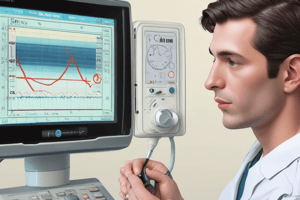Podcast
Questions and Answers
Which phase of Korotkoff's sounds is characterized by a swishing/whooshing sound?
Which phase of Korotkoff's sounds is characterized by a swishing/whooshing sound?
- Phase 1
- Phase 4
- Phase 2 (correct)
- Phase 3
Which phase provides the systolic pressure reading during blood pressure measurement?
Which phase provides the systolic pressure reading during blood pressure measurement?
- Phase 2
- Phase 4
- Phase 3
- Phase 1 (correct)
What sound is heard during Phase 3 of Korotkoff's sounds?
What sound is heard during Phase 3 of Korotkoff's sounds?
- Swishing/whooshing sound
- Softer, blowing, muffled sound that fades
- Thump (softer than phase 1) (correct)
- Silence
During which phase is the diastolic pressure reading first identified?
During which phase is the diastolic pressure reading first identified?
Which method is used for measuring blood pressure by applying external pressure on the artery?
Which method is used for measuring blood pressure by applying external pressure on the artery?
What is the term for the period of silence during blood pressure measurement using Korotkoff's sounds?
What is the term for the period of silence during blood pressure measurement using Korotkoff's sounds?
What is the term used to describe the silence that occurs when the cuff pressure is released enough to allow normal blood flow?
What is the term used to describe the silence that occurs when the cuff pressure is released enough to allow normal blood flow?
In which situation would a nurse most likely use the palpatory method for assessing blood pressure?
In which situation would a nurse most likely use the palpatory method for assessing blood pressure?
What can happen if a nurse assesses blood pressure immediately after a meal or while the client is in pain?
What can happen if a nurse assesses blood pressure immediately after a meal or while the client is in pain?
Which common error in assessing blood pressure involves the temporary disappearance and reappearance of sounds at a lower level?
Which common error in assessing blood pressure involves the temporary disappearance and reappearance of sounds at a lower level?
What might occur if the cuff is wrapped too loosely or unevenly during blood pressure assessment?
What might occur if the cuff is wrapped too loosely or unevenly during blood pressure assessment?
Which of these statements about diastolic pressure is correct?
Which of these statements about diastolic pressure is correct?
What is the typical range for a normal pulse pressure?
What is the typical range for a normal pulse pressure?
Which phase of Korotkoff's sounds corresponds to the systolic pressure reading?
Which phase of Korotkoff's sounds corresponds to the systolic pressure reading?
What is the formula for calculating pulse pressure?
What is the formula for calculating pulse pressure?
During the auscultatory gap, which Korotkoff sound is temporarily inaudible?
During the auscultatory gap, which Korotkoff sound is temporarily inaudible?
What technique is used to measure blood pressure by detecting Korotkoff's sounds?
What technique is used to measure blood pressure by detecting Korotkoff's sounds?




